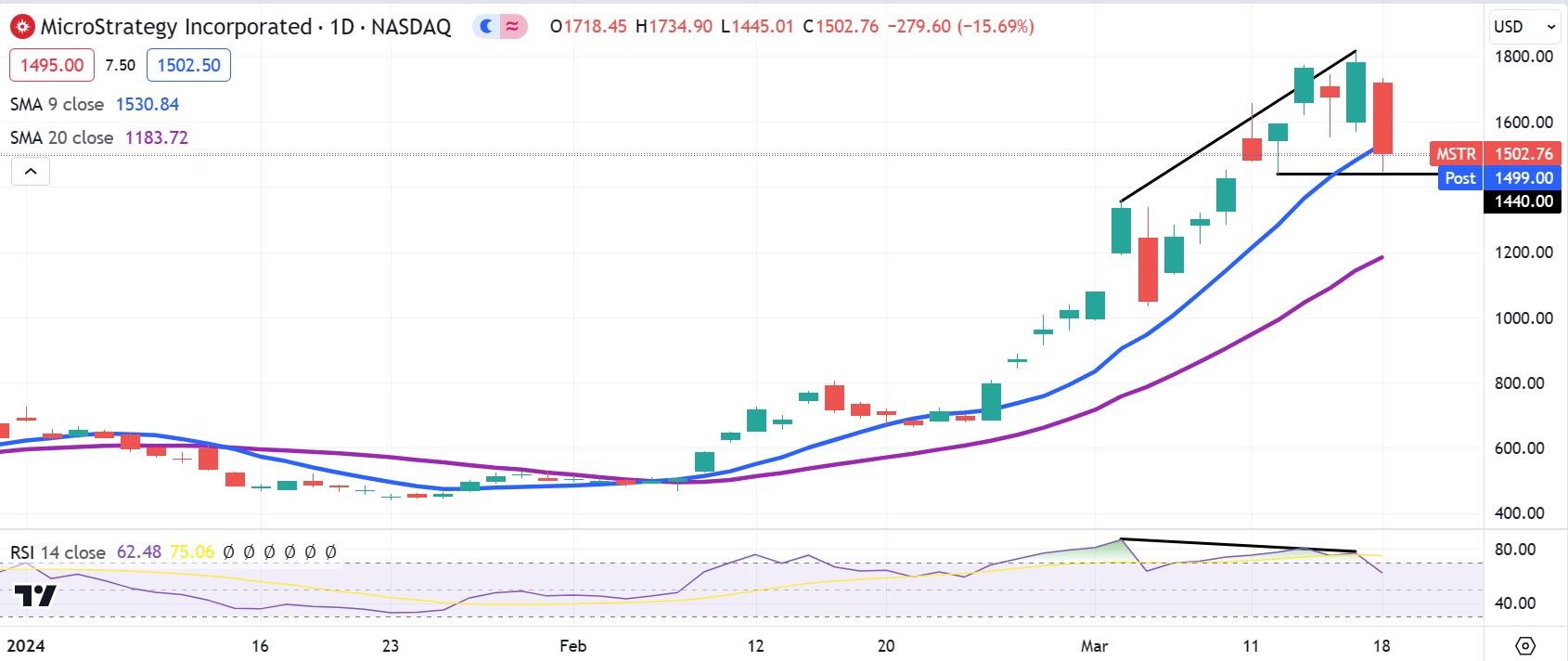- MicroStrategy lost more than 15% on Monday.
- This considerable pullback follows three weeks of rallying.
- CEO Saylor in the market for another $575 million.
- MSTR is up 138% YTD in 2024.
MicroStrategy (MSTR) stock shunted lower a whopping 15.7% on Monday. The pullback came alongside a continued slackening over the weekend in the price of Bitcoin, which lost as much as 2% during the session to trade near $67,000.
Since stocks tied to the price of Bitcoin like MicroStrategy don’t trade over the weekend, they can experience serious volatility on Monday after catching up to the weekend’s Bitcoin dynamics.
MSTR stock moved in contrast, closing at $1,502.76 to the broader market as the S&P 500 rose about 0.6% and the NASDAQ registered a gain near 0.8%.
MicroStrategy stock news
MicroStrategy stock is still up 138% year to date, so this pullback should be viewed in the wider scheme of things. During the previous three weeks, MSTR stock clocked in gains of 57%, 32% and 25% in consecutive order.
That means that it was high time for a pullback. Still many traders took the chance to dunk on MSTR across social media. Some mentioned that CEO Michael Saylor has been selling MSTR shares, albeit those related to stock options. This back-in-forth spat in turn drove supporters to pile on.
Those bullish about Bitcoin still have major reasons for optimism though. The market is just 30 days away from the halving event in which miners receive a 50% reduced reward for mining a new block of BTC. In the past, this has caused a large surge in price action for BTC in the 18 months following a halving event since it means that miners are selling a drastically-reduced amount of Bitcoin on average.
Last Wednesday, Saylor and company announced that it would be selling another $500 million worth of convertible senior notes in a private offerings to fund further purchases of Bitcoin. The notes are due in 2031 and allow the buyers to purchase an additional $75 million if desired. The software company already owns 205,000 or so BTC coins.
This announcement came on the heels of an earlier announcement that MicroStrategy had purchased 12,000 Bitcoins following a successful $781 million sale of convertible senior notes.
S&P 500 FAQs
The S&P 500 is a widely followed stock price index which measures the performance of 500 publicly owned companies, and is seen as a broad measure of the US stock market. Each company’s influence on the computation of the index is weighted based on market capitalization. This is calculated by multiplying the number of publicly traded shares of the company by the share price. The S&P 500 index has achieved impressive returns – $1.00 invested in 1970 would have yielded a return of almost $192.00 in 2022. The average annual return since its inception in 1957 has been 11.9%.
Companies are selected by committee, unlike some other indexes where they are included based on set rules. Still, they must meet certain eligibility criteria, the most important of which is market capitalization, which must be greater than or equal to $12.7 billion. Other criteria include liquidity, domicile, public float, sector, financial viability, length of time publicly traded, and representation of the industries in the economy of the United States. The nine largest companies in the index account for 27.8% of the market capitalization of the index.
There are a number of ways to trade the S&P 500. Most retail brokers and spread betting platforms allow traders to use Contracts for Difference (CFD) to place bets on the direction of the price. In addition, that can buy into Index, Mutual and Exchange Traded Funds (ETF) that track the price of the S&P 500. The most liquid of the ETFs is State Street Corporation’s SPY. The Chicago Mercantile Exchange (CME) offers futures contracts in the index and the Chicago Board of Options (CMOE) offers options as well as ETFs, inverse ETFs and leveraged ETFs.
Many different factors drive the S&P 500 but mainly it is the aggregate performance of the component companies revealed in their quarterly and annual company earnings reports. US and global macroeconomic data also contributes as it impacts on investor sentiment, which if positive drives gains. The level of interest rates, set by the Federal Reserve (Fed), also influences the S&P 500 as it affects the cost of credit, on which many corporations are heavily reliant. Therefore, inflation can be a major driver as well as other metrics which impact the Fed decisions.
MicroStrategy stock forecast
Once again, a pullback in MSTR stock at this juncture should not be overly worrisome to shareholders. Rather, these shakeouts are common when a stock has heavy trading in the options markets.
A good sign is that MicroStrategy halted its intraday lows near $1,440. This time the daily low was also above the March 12 low of $1,438. That gives this level a certain significance. If MSTR bounces off here tomorrow, the rally will be back on.
However, a break of $1,440 will send a certain swath of traders bailing this week. If that is the case, expect MSTR to descend to the $1,200 level. This price coincides with the 20-day Simple Moving Average (SMA), as well as considerable price action from earlier this month.
MSTR daily stock chart
Information on these pages contains forward-looking statements that involve risks and uncertainties. Markets and instruments profiled on this page are for informational purposes only and should not in any way come across as a recommendation to buy or sell in these assets. You should do your own thorough research before making any investment decisions. FXStreet does not in any way guarantee that this information is free from mistakes, errors, or material misstatements. It also does not guarantee that this information is of a timely nature. Investing in Open Markets involves a great deal of risk, including the loss of all or a portion of your investment, as well as emotional distress. All risks, losses and costs associated with investing, including total loss of principal, are your responsibility. The views and opinions expressed in this article are those of the authors and do not necessarily reflect the official policy or position of FXStreet nor its advertisers. The author will not be held responsible for information that is found at the end of links posted on this page.
If not otherwise explicitly mentioned in the body of the article, at the time of writing, the author has no position in any stock mentioned in this article and no business relationship with any company mentioned. The author has not received compensation for writing this article, other than from FXStreet.
FXStreet and the author do not provide personalized recommendations. The author makes no representations as to the accuracy, completeness, or suitability of this information. FXStreet and the author will not be liable for any errors, omissions or any losses, injuries or damages arising from this information and its display or use. Errors and omissions excepted.
The author and FXStreet are not registered investment advisors and nothing in this article is intended to be investment advice.
Recommended content
Editors’ Picks

AUD/USD retakes 0.6000 on the road to recovery amid US-China trade war
AUD/USD is off the five-year low but remains heavy near 0.6000 in the Asian session on Monday. The pair continues to suffer from a US-China trade war as US President Trump said that he would not do a deal with China until the US trade deficit was sorted out.

USD/JPY attempts tepid recovery above 146.00
USD/JPY kicks off the new week on a weaker note, though it manages to stage a tepid recovery above 146.00 early Monday. The global carnage, amid the mounting risk of a recession and a trade war led by Trump's sweeping tariffs, keeps the safe-haven Japanese Yen underpinned at the expense of the US Dollar.

Gold buyers refuse to give up amid global trade war and recession risks
Gold price is holding the quick turnaround from one-month lows of $2,971, consolidating the recent downward spiral. The extension of the risk-off market profile into Asia this Monday revives the safe-haven demand for Gold price.

Bitcoin could be the winner in the ongoing trade war after showing signs of decoupling from stocks
Bitcoin traded above $84,000 on Friday, showing strength despite the stock market experiencing significant declines. The market reaction stems from United States President Donald Trump's clash with the Federal Reserve Chairman Jerome Powell over interest rate decisions.

Strategic implications of “Liberation Day”
Liberation Day in the United States came with extremely protectionist and inward-looking tariff policy aimed at just about all U.S. trading partners. In this report, we outline some of the more strategic implications of Liberation Day and developments we will be paying close attention to going forward.

The Best brokers to trade EUR/USD
SPONSORED Discover the top brokers for trading EUR/USD in 2025. Our list features brokers with competitive spreads, fast execution, and powerful platforms. Whether you're a beginner or an expert, find the right partner to navigate the dynamic Forex market.




